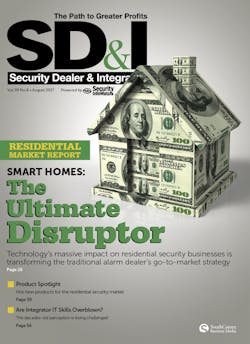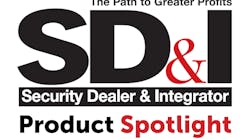Just three years ago, Apple HomeKit was said to signify the dawn of the so-called “smart home revolution.” The residential security industry was put on notice: Things were probably going to change – the question was, would it be for the better?
Fast forward to the summer of 2017, and the technology revolution rooted in the smart home has literally changed the face of the residential security sector.
New products – whether DIY alarms, A/V, smart home, something unifying all aspects of technology in the home – are coming to market on a daily basis. These products tend to have shorter life spans, mainly because something newer and better is always being developed behind the scenes.
“There will always be new things coming out every year,” says Inder Reddy, President of Honeywell Security Products Americas. “Voice control has really taken off. My son is 10 years old, and he hardly ever types anything, and he doesn’t want to read anything. You will see more and more of this connectedness, and (manufacturers) need to make systems connect to these technologies now and also be ready for something else that comes along down the road.”
The technology explosion has had a profound effect on the security dealers and integrators who service the residential market. Whether a “mom and pop” dealer or a huge national player, the vast influx of potential offerings and services for a typical home security user has made murky what was once a straightforward, stable business plan based on recurring revenue.
“Capital investors aren’t sure that a dollar of RMR these days is as stable as it has been in the past,” Michael Barnes, founding partner of Barnes Associates, an investment banking firm that offers financial advisory services to the security alarm industry, said during a recent session at the ESX conference. “(Investors) view the industry to be riskier because there are new players, new technologies and things are changing so quickly – which is creating a higher level of perceived risk with our industry, even if these risks are overblown.”
Despite the higher level of uncertainty, there is no doubt that the incursion of smart home technologies is also having a positive impact. The numbers from industry powerhouses like ADT suggest the long-standing 20-25 percent penetration rate that has been drilled into the residential alarm industry is finally moving in the right direction.
“We always wondered if the market is going to stick at 20-25 percent forever,” admits Jeffrey Gardner, President and CEO of MONI Smart Security. “Now, I think (new technology) has opened the opportunity to go much higher.”
Adds Glen Smith, ADT’s Director of Dealer Operations: “As we see the next generation stepping in and realizing the potential of the smart home, I think we will see a really dramatic swing.”
Of course, even that good news comes with a caveat: “In a connected home world, the security space has been the single most positively impacted market,” Scott Harkins, Vice President of Honeywell Connected Home, told a room packed full of alarm dealers at ESX.
“This is the industry making money on smart homes, but since we are successful, there are a whole bunch of companies that want to get into it – many on the DIY model,” Harkins adds. “There’s a target on this industry’s back by companies that want to get a piece of that money.”
The Three Impacts of New Technology
According to Barnes, there are three technologically-driven trends affecting performance and values for residential alarm companies. The first, he said in his ESX session, is faster product evolution and shorter lifecycles. “The number of new products coming out every day is much faster than it has been in the past, and those products are expected to have much shorter lifecycles – not because they aren’t being manufactured well, but because they will be replaced with something faster, better or cheaper,” he says.
Barnes’ second big trend is tied directly to that influx of new products, which now gives dealers a much broader array of capabilities and potential services to offer their customers. “This is a wonderful thing for consumers and end-users,” Barnes says, “although it puts a strain on those of us providing those services. How do you offer them, how do you package them, and how do you price them?”
The third trend, Barnes says, is the changing competitive landscape. “Clearly, technology is enabling some of these new competitors to enter the market – companies from industries that previously wouldn’t have been a competitor without these technological advances.”
While Barnes says that each of these indicators represent stability and opportunity, it also means there is obviously much more complexity.
Eroding Margins
As Honeywell’s Reddy said, manufacturers are doing their best to not only keep pace with today’s technology and consumer demands, but also being sure that those products can still be relevant one, five and even 10 years down the road. It also means that there is pressure on dealers to be able to offer their customers the newest gadget or feature in addition to the tried-and-true alarm panels.
“In the old days, it was a very slow evolution from one product to the next, and the industry itself – those who installed and serviced those products – vetted them,” Barnes explains. “With all the exciting new stuff coming out, I am afraid that vetting process isn’t occurring – (dealers) are grabbing the newest shiny thing, sending it out there and hoping it works; meanwhile, pricing pressure means that stuff is going out there pretty inexpensively.”
Adds Mitchell Klein, the Executive Director of the Z-Wave Alliance: “With the proliferation of smart home devices comes inherent risk – not every product is going to work out of the box, and not every product will continue to be supported a year or two from now. (Dealers must) investigate what technologies and platforms have staying power, backwards compatibility and reliability. Know the difference between a passing fad and a worthwhile product that works and adds value and you’ll save yourself headaches and service calls down the road.”
Traditional dealers are accustomed to a certain sales model: Hardware sold below cost that is covered over the time of its use by recurring revenue services such as monitoring. This model is beginning to shift with the shorter lifespans of the products themselves; and to make matters more difficult, a consumer still expects to cash in on those up-front discounts.
“(Dealers) did not anticipate having to upgrade the (newer smart home) equipment as often as they have had to,” Barnes explains. “That creates pressure on the margins on the monitoring and services side, while there is no relief on the products side, as customers still expect those discounts. Thus, the economics of the industry are likely to adjust.”
That margin pressure is hopefully counterbalanced by dealers’ ability to offer so much more to a customer in the form of new products and services.
Security Technology for a New Lifestyle
The new products and technologies, for the most part, are anchored on the one item everyone seems to have within reach at all times: smartphones.
The same cannot be said for traditional security/alarm system. While many vendors – such as Honeywell and Alarm.com and others – have seized on this trend by expanding mobile control into the overall security ecosystem, the industry is still lagging behind the smart home/lifestyle products, which all come with an app.
“The biggest risk to the pro security market is that we are still hovering around 50-60 percent connected,” Honeywell’s Harkins says. “There is a level of expectation by consumers that their systems will be connected, and we need to sell that connected piece.”
These connected, so-called interactive services are on a sharp upswing among residential security product vendors, who – like their dealer partners – are finding themselves in direct competition with inexpensive, DIY “security kits” that can be found on the shelf in a Costco or Home Depot. Case in point: In April of 2017, ADT announced their two millionth customer of the Pulse interactive security and home automation platform.
“When we look at new sales, almost 88 percent of our new customers have interactive services,” says Peter Tonti, VP of Product Marketing for MONI. “Of that 88 percent, about 26 percent are doing something above interactive – which is full home automation.”
The issue for MONI dealers and many others is not the new installs – it is their base of loyal customers, roughly half of whom still rely on systems that provide zero mobile interaction, or even worse, straight analog.
“Dealers will need to do a lot of outsourcing,” Barnes says. “(Outsourcing) with someone like Alarm.com allows (dealers) to increase recurring revenue, and there is great statistical evidence that it makes the customer stickier. But now you are outsourcing that function with them, and now you have a supplier you rely on heavily for that service – which means it is not so easy to migrate away from that service if you ever chose to do so.”
The Shiny Objects and How to Incorporate Them
The incursion of tech giants into the security industry is generally viewed with skepticism by traditional security dealers; however, innovation by Silicon Valley stalwarts like Apple, Microsoft and Google has actually opened the floodgates on adoption.
“New innovations in areas such as voice control, AI and machine learning are driving the next wave of smart home adoption,” says Jennifer Kent, Director of Research Quality and Product Development for Parks Associates. “These technologies make smart home solutions smarter and more intuitive for consumers to use.”
Voice control is perhaps the biggest recent technology disruptor in the residential market. “Overall, for the smart home to engage the entire home – not just one or two users – mobile apps will need to be replaced by (in-home displays) or voice assistants,” explains Blake Kozak of market research firm IHS. “Phone or tablet apps will likely continue to be used for initial configuration; however, sustainable, strong growth in the smart home depends on a more immersive experience through voice or displays, where everyone in a home can engage the ecosystem.”
Today, dealers can offer so many smart devices, it boggles the mind. The most successful products on the smart home market, according to market research firm Berg Insight, include smart thermostats, security systems, smart light bulbs, network cameras and multi-room audio systems. That said, many experts caution dealers not to jump in on everything.
“The biggest impact is the blurring of your identity (as a security dealer),” Barnes warned. “It is important to position yourself in the market to stay competitive in the long term.”
This blurring of identity has become something of an internal (and sometimes even external) debate among security dealers – do you lead with the stability and seriousness of home security, or do you lead with the attractiveness and appeal of smart home technologies? In the end, it is a difficult but vitally important internal decision.
“We are absolutely recommending dealers to lead with the full connected home and services piece,” Honeywell’s Reddy says, “because even though security is still the foundational element of that, if you don’t market with the smart home, you are putting yourself at a disadvantage.”
MONI’s Tonti does not see it going so far: “It has started to change, but I don’t think it has gone all the way to selling the smart home first. It depends on the customer: If it is someone who thinks of security as a part of an overall smart home, then yes, it would make sense to sell them on smart home products integrated with a security system.”
Barnes takes a more cautious approach: “Companies that still emphasize the security aspect, in my opinion, are arguably in a better position,” he says. “If you lead with other services, you may be playing into what the cable companies want you to do – which is try to compete with them on entertainment. The problem is trying to figure out the right mix – you have to try and offer a competitive array of products, but you can’t try to be all things to everybody.”
Technology’s Impact on Competition
While smart home innovation has dramatically changed the options for available technologies and services for dealers and their customers, perhaps the most dangerous element is that it has enabled a vast new wave of competition that comes in two major forms – ironically one very large and the other extremely small: MSOs and DIY.
“Since I’ve been in the business, every five years people would say somebody was going to put me out of business – today it’s SimpliSafe,” says John Knox, who has owned Knox Integrated Systems for more than 45 years. “We have been dealing with that our whole lives…and we are still here.”
“(Comcast) is here to stay, and I think the industry is better for having us,” Daniel Herscovici, Comcast’s senior vice president and general manager for Xfinity Home, said in an exclusive audio interview with SD&I at ESX. “While we do meet each other in the marketplace, I truly believe that a rising tide lifts all boats. We are growing and educating the market overall, and when we do that, it helps the industry.”
Barnes agrees that Comcast and other MSO players are likely here for good. “There is competition in two areas,” he explains. “It is not just the pressure to get new sales against the MSO offerings, but also the pressure on existing customers, who, for example, would ask why you are charging this much when they can get a brand new system for less.”
Most alarm industry followers see DIY challengers coming in the form of a SimpliSafe; however, Harkins says the real threat is the multitude of DIY home video surveillance systems available via many retailers.
“DIY cameras vastly outsell security systems on an annual basis,” he says. “There are four million home security systems installed per year consistently; there are 8 to 10 million all-in-one video surveillance systems like Canary being sold per year. (People who buy those systems) might think of it as security, but really they are buying awareness, and security professionals need to help change that perception.”
Impact on the Customer Relationship
Technology is indeed having a major impact on dealers and vendors in terms of their businesses and go-to-market strategies, but it is also having a major effect on a dealer’s traditional relationship with a customer. “The industry has really turned 180 degrees on the idea that once you sell the customer, you leave him alone,” MONI’s Gardner says.
Adds Barnes: “20 or 30 years ago, you installed a system, it worked, and you rarely communicated with that customer except when something occasionally had to be fixed or upgraded – that is not today’s reality. Now, you need to communicate with the customer much more frequently. This is a new phenomenon for many (traditional) alarm companies.”
This communication takes many forms – arguably the most important of which is helping customers actually use the interactive services. “Today, a customer might interact with their smart devices on a daily basis, and as such, may need support and have ongoing questions,” Z-Wave Alliance’s Klein says. “(Dealers must) be the expert and go-to person for that customer.”
Dealers must also stay in communication with long-time customers to keep them informed about the new technologies that have been released and their availability.
The Top 6 Habits of Highly Effective Companies
Taking all of these impacts into account, Barnes has narrowed the formula for successful embrace of today’s technologies in the residential security space into six characteristics of effective companies:
1. Operationally focused: “It is important to be focused,” he says. “For example, (our company) operates within 60 miles of our location, and that’s our market; or it could be focusing on a market segment, such as renters.” Whatever the focus, it must be something very specific, he adds.
2. Fast-followers: When it comes to adopting new technologies, “the companies who do best aren’t out plowing new snow, taking the brand new thing, seeing if it works and figuring out the price; instead, they keep an eye on the others who do that,” Barnes explains. “As soon as it works – the pricing is right, the product works and it is well supported, the margins are defined – they jump on. There is a little risk in doing that, but most companies can catch up pretty quick.”
3. Well-defined identity: “You need to be crystal-clear about who you are,” Barnes says. “Customers don’t want to be unsure if you do HVAC or alarms or both – you must have a very crisp identity.”
4. High-energy corporate culture: “It pretty much goes without saying – companies with a high-energy culture always perform better than those that do not,” he says.
5. Data-driven: “This industry is complicated – pricing is difficult, raising capital is difficult – and it all requires data,” Barnes says. “This is not an industry that should be making gut decisions anymore. Companies must be mindful of their metrics, have the numbers and make decisions based on that data.”
6. Access to capital: “If you are going to drive growth, it takes capital,” Barnes concludes. “If it takes $28 to originate a dollar of RMR, then you must have access to that $28.”
Paul Rothman is Editor in Chief of Security Dealer & Integrator (SD&I) magazine. Access the current issue, archives, subscription links and more at www.secdealer.com.







